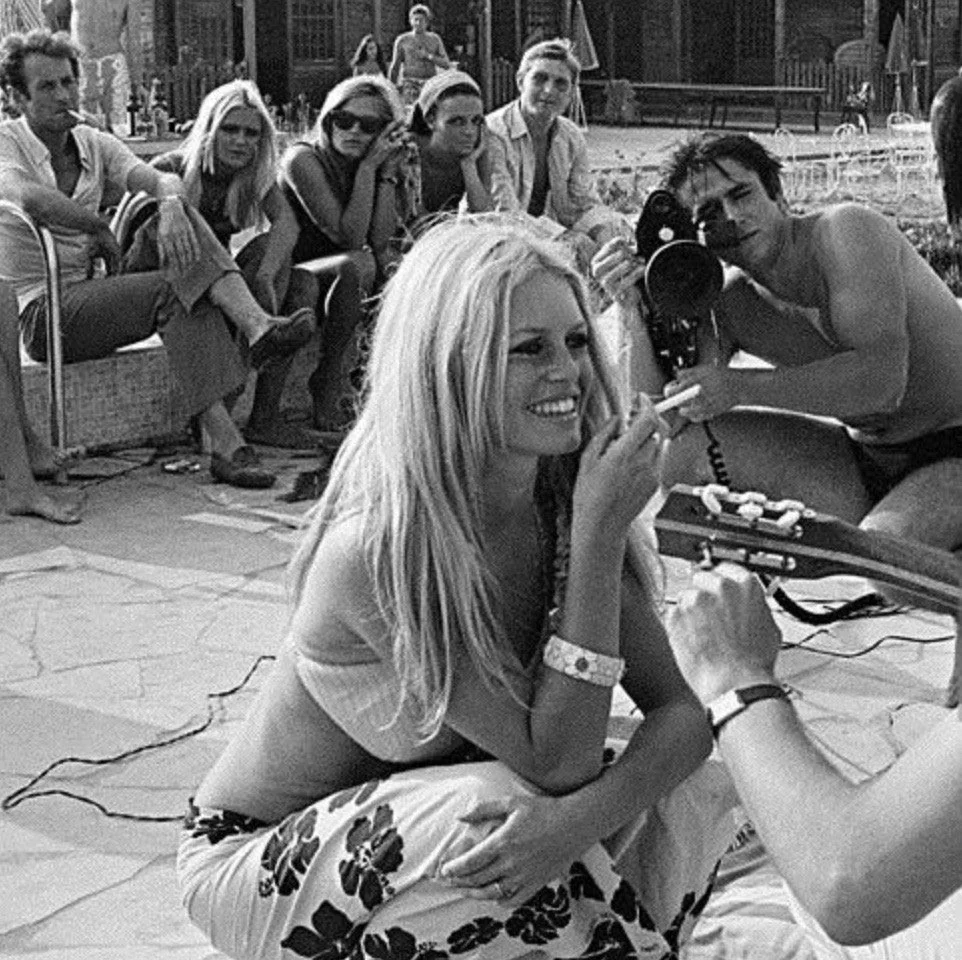Why you will never be an ‘It Girl’
and why that should set you free …
Take it from another someone who’s also spent an alarming amount of time admiring, or at least finding obscure fascination with, It Girls...
We’re being taught how to become It Girls, and that’s precisely why we never will be one.
The term It Girl was first coined in the 1920s to describe Clara Bow, the silent film starlet who lit up the screen with her sex appeal, sass, and signature chaos. She was the walking embodiment of the Roaring Twenties: she was peppy, sensual, effortlessly magnetic, with a certain aloofness that proved her lack of self-consciousness. Clara didn’t follow trends, she was too busy inventing them. To be an It Girl meant daring to be wildly, unapologetically, unthinkingly yourself - in a way that nobody could do but you.
Fast forward, and It Girl-ism has been boiled down, diluted, packaged and monetised into algorithm-approved ‘aesthetics.’ One mindless scroll on TikTok and suddenly you’re knee-deep in “How To Become That Girl” guides. You know the ones:
“How to romanticise your life by making matcha and walking slowly in beige linen.”
“How to be an off-duty model (without the career, or cheekbones).”
“How to be a Clean Girl™ - just rid your self of personality!”
“How to do this totally unique eyebrow shape that’s, like, so you (and every other 20-something on the internet).”
It’s no longer about being you, and embodying the truest sense of this. It’s about slotting yourself neatly into the algorithm’s latest pre-approved identity kit. And as each wave of micro-trends crashes into the next, we're left clutching at aesthetics like flotation devices. Gone is the originality, the contradiction, the chaos that made the It Girls so… it.
Instead of igniting the self through play, through experimentation, trial, error, and gleeful unpredictability; we’re stuck in a digital echo chamber where everyone is contrived and ‘cool’ in exactly the same self-soothing way.
We busy ourselves so much with the thought of how to be, that we spend far too little time actually being.
But what if being “not it” is actually the most “it” thing you can be?
It’s the formula we know off by heart by now: vinted hauls, digital camera flashes, hair unkept but in that strategic Kate Moss way, matcha lattes * ironically of course *, being attuned to trends but at least three months before everyone else (duh), having depth but also being ditzy! silly! fun!
A perfect dose of this, a dash of that and finally! you’re it! you’re her.
A part from: so is everyone else.
We’re scrolling into the oblivion of Blueprint Culture, where individuality is reverse-engineered through mood boards and copy-cat behaviour. The "It Girl" is no longer a person but, a product. A carousel of outfit inspo slides. A twenty-step morning routine. A disposable identity disguised as self-discovery.
Where once It Girls emerged because they broke the mould, we now chase it, glue it to our vision boards, and spend hundreds trying to replicate it. It's no longer who you are, but how well you can perform a certain ideal. The girl who used to get noticed because she walked into the room radiating something off-centre is now pinned by her wings to the mood boards of our minds from which our every move pivots. She is dissected within an inch of her life.
Unpredictability becomes predictable and authenticity becomes content.
Bardot, Birkin, and Pamela…
There’s something funny about how often we romanticise the women we call It Girls, when most of them didn’t seem even particularly interested in being anyone’s idea of one.
Take Brigitte Bardot, all tousled hair and cigarette smoke with a refusal to play nice. She didn’t chase after approval. If anything, she rejected the notion. She was messy, political, unpredictable. Her image was of course seductive, but what made her striking was that she didn’t package herself for anyone. She had aloofness, and energy, and a distinct uniqueness that only emerges in a commitment to being yourself.
Jane Birkin was chaotic in her timelessly charming way. Her outfits looked like they’d been pulled from the floor, her hair constantly falling into her eyes. She didn’t iron things. She didn’t overthink things. She just was. There’s a story of her cutting up her Hermès bag with a pair of scissors to make it more practical and if there was ever a metaphor for anti-perfection, that’s it.
And then there’s Pamela Anderson, who, after decades of being styled and sexualised and filtered through a very specific male gaze, walked into Paris Fashion Week bare-faced, no makeup, no façade. And when people asked why, she just said:
“I just wanted to look like myself.”
Not to make a point. Not to start a trend. Just... because.
Unfortunately, there’s now something radical in that. We’re all so used to seeing people pre-approved and polished before they enter the room. And yet the women who linger in the cultural memory, who are eternalised in social consciousness, continuing to disrupt the stale and dust even today, are the ones who weren’t trying to be anything other than themselves at all.
They didn’t represent some impossible ideal. They just felt real. Slightly undone. A little contradictory. The kind of people who didn’t need to be the centre of attention, but couldn’t help drawing it anyway.
And that’s the part we can actually learn something from: not the styling, not the haircuts, and not the performance. Just the quiet confidence of showing up as yourself. Even if that self is a bit chaotic or confusing at times. Maybe especially then.
Awaken the self through play, not performance…
‘Reawaken the possibility of possibility. Reawaken it with play’
True It Girl energy isn’t calculated nor curated. It’s something you stumble into by accident when you’re too busy being excited by the possibility of life to obsess about how you look living it.
You have to awaken the self through play - and by play, I mean experimentation, contradiction, joy, boredom, risk, and that little bit of delusion. You go out on a limb. You try things. You mess up. You feel strongly. You stumble into the negative space of yourself. You exist in shadow, you carve out light. You laugh, loudly. And you do it all again despite itself.
As Girls actress Jemima Kirke once so perfectly quipped: “Maybe you’re thinking of yourself too much.”
And that’s kind of it, isn’t it? Maybe the biggest barrier between us and It Girl-hood is that we’re hyper-fixated on how to be one, concerned by how we’re perceived, micromanaging others’ understanding of us, nitpicking every last morsel of self expression, living in the mind and giving less to the embodiment of ourselves…
The original It Girls didn’t sit around, diagnosing their personal brand. They were too busy living; dancing badly, falling in and out of love, being contradictory, and accidentally igniting trends by virtue of just being present in their own chaos.
The irony isn’t lost on me…
Of course, the starkest irony of this blog piece is that it, too, is doing exactly what it claims to critique.
We are, right now, dissecting It Girl culture. Poking at it with tweezers. Citing Jane Birkin and Pamela Anderson in a bid to deconstruct coolness, which, let’s be honest, is just another form of trying to be cool.
Let it be known: this isn’t a manifesto for becoming different or special or cool. It’s actually a note of permission, if any was needed, to stop caring so much about being those things.
Because truthfully? There’s nothing wrong with having your inspirations, enjoying a trend, or being ‘like every other girl’. The phrase is often used in back hand, as I’m sure we all have been slighted by “you’re not like other girls”- but who decided that girls en masse weren’t interesting? Who said that following a guide or being basic in public made you any less worthy of attention?
The real subversive act might not be breaking the mould, it might just be being a part of it or conversely, not a part of it without shame or really, thought. To play, to fail, to conform and rebel, sometimes on the same day. To exist somewhere between irony and sincerity, knowing that nothing matters as much as people on the internet claim it does.
The illusion of the ‘It Girl’.
You will never find joy in shoe horning yourself into the contrived notions of the It Girl, nor will you find yourself.
Joy often emerges in those fleeting, golden moments and lightness. Times when you let go of the self-surviellence. When you let go of contrived notions of what to be, how to be, and when to be it. When you share vulnerability, a feeling, an outfit, a piece of writing, a moment of laughter, a weird little habit, and someone says ‘same’.
That’s not branding. That’s community. That’s what actually matters.
Lets be honest: most of us won’t be remembered as the definitive It Girl of our generation. We won’t be a marble statue or cover on Vogue. But maybe we will be remembered as the girl who committed to her truest sense of self, and gave others the courage to do the same. And really, isn’t that the most flattering superlative of all?
You don’t have to be someone. You just have to be you. And if you do it boldly enough, with enough play, joy, and generosity, maybe that’s all the ‘it’ you’ll ever need.




